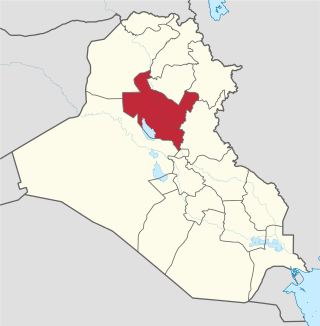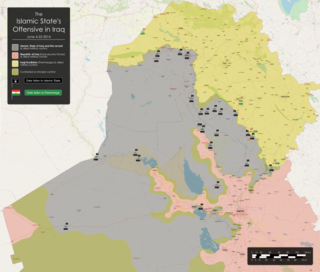
The Northern Iraq offensive began on 4 June 2014, when the Islamic State began a major offensive from its territory in Syria into Iraq against Iraqi and Kurdish forces, following earlier clashes that had begun in December 2013 involving guerillas.
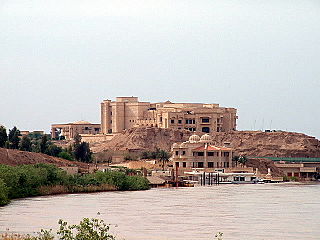
The First Battle of Tikrit was a battle for the Iraqi city of Tikrit following the city's capture by the Islamic State and Ba'athist Loyalists during the 2014 Northern Iraq offensive. The battle took place between 26 and 30 June 2014.
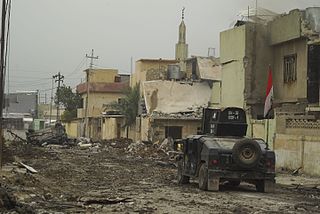
The War in Iraq was an armed conflict between Iraq and its allies and the Islamic State which began in 2013 and ended in December 2017. Following December 2013, the insurgency escalated into full-scale guerrilla warfare following clashes in the cities of Ramadi and Fallujah in parts of western Iraq, and culminated in the Islamic State offensive into Iraq in June 2014, which lead to the capture of the cities of Mosul, Tikrit and other cities in western and northern Iraq by the Islamic State. Between 4–9 June 2014, the city of Mosul was attacked and later fell; following this, Prime Minister Nuri al-Maliki called for a national state of emergency on 10 June. However, despite the security crisis, Iraq's parliament did not allow Maliki to declare a state of emergency; many legislators boycotted the session because they opposed expanding the prime minister's powers. Ali Ghaidan, a former military commander in Mosul, accused al-Maliki of being the one who issued the order to withdraw from the city of Mosul. At its height, ISIL held 56,000 square kilometers of Iraqi territory, containing 4.5 million citizens.
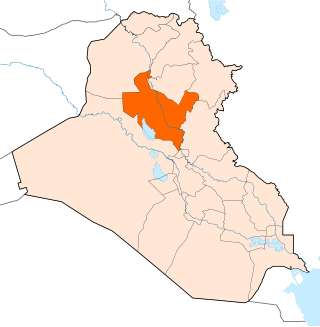
The siege of Amirli was a siege of the predominantly Shi'ite Turkmen town of Amirli in Iraq by the Islamic State of Iraq and the Levant (ISIL) during the War in Iraq. The town was besieged by ISIL forces from June 2014, lacking access to food, electricity, and water. Most of the residents are Shia Turkmen, who had organized local self-defense militias to fight against ISIL. On August 31, the Iraqi military reportedly broke the siege and entered the town. It has been described as "Iraq's biggest victory against ISIS", as of September 2014.
The following lists events that happened during 2014 in Iraq.

The Battle of Baiji was a battle that took place in Baiji, Iraq, lasting from late October 2014 to late October 2015. In mid-November 2014, Iraqi forces retook the city of Baiji, and re-entered the Baiji Oil Refinery. However, fighting continued in the region, and on 21 December 2014, ISIL forces took Baiji and put the Baiji oil refinery under siege once again, before Iraqi forces recaptured the city on October 22. It gave Iraqi forces complete control of the highway stretching from Baghdad to Baiji, and allowed Iraqi forces to use Baiji as a base for launching a future assault on Mosul.
The Battle of Ramadi, also called the Fall of Ramadi, was part of an ISIL offensive to capture all of the Anbar Province. Ramadi was one of the Iraqi government's last strongholds in Anbar, after ISIL's success in a previous campaign. The battle began in November 2014, and drew to a close on 14 May 2015, as Islamic State of Iraq and the Levant (ISIL) insurgents seized hold of government buildings. On 17 May, the Iraqi Army and special forces fled the city, with 500 civilians and security personnel dead.

The Sinjar offensive was a combination of operations of Kurdish Peshmerga, PKK and People's Protection Units forces in December 2014, to recapture regions formerly lost to the Islamic State of Iraq and the Levant in their August offensive.
This is a timeline of events during the War in Iraq in 2015.
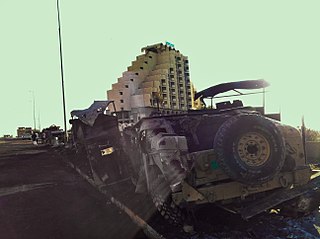
The fall of Mosul occurred between 4–10 June 2014, when Islamic State insurgents, initially led by Abu Abdulrahman al-Bilawi, captured Mosul from the Iraqi Army, led by Lieutenant General Mahdi Al-Gharrawi.

The Second Battle of Tikrit was a battle in which Iraqi Security Forces recaptured the city of Tikrit from the Islamic State of Iraq and the Levant (ISIL). Iraqi forces consisted of the Iraqi Army and the Popular Mobilization Forces, receiving assistance from Iran's Quds Force officers on the ground, and air support from the American, British, and French air forces.
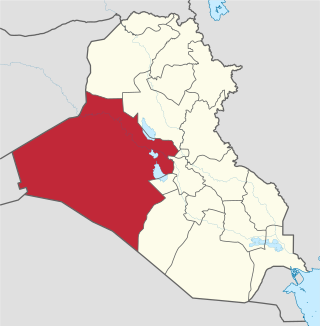
The Al-Karmah offensive, codenamed Fajr al-Karma, was an offensive launched by the Iraqi Army and anti-ISIL Sunni tribal fighters to recapture the Al-Karmah district taken by the Islamic State of Iraq and the Levant in Iraq. The offensive began on 14 April 2015. During the offensive the anti-ISIL forces captured part of the city of Al-Karmah, and the old road of Al-Karmah.

The Mosul offensive (2015) was an offensive launched by Kurdish Peshmerga forces on 21 January 2015, with the objective of severing key ISIL supply routes to Mosul, Iraq, and to recapture neighboring areas around Mosul. The effort was supported by US-led coalition airstrikes. The Iraqi Army was widely expected to launch the planned operation to retake the actual city of Mosul in the Spring of 2015, but the offensive was postponed to October 2016, after Ramadi fell to ISIL in May 2015.
In early 2014, the jihadist group Islamic State of Iraq and the Levant captured extensive territory in Western Iraq in the Anbar campaign, while counter-offensives against it were mounted in Syria. Raqqa in Syria became its headquarters. The Wall Street Journal estimated that eight million people lived under its control in the two countries.
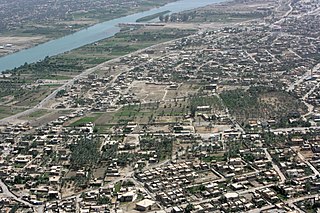
The Battle of Ramadi was a battle launched by the forces of Iraq to successfully recapture the city of Ramadi from the Islamic State of Iraq and the Levant (ISIL), which had taken the city earlier in 2015 in a previous battle. Air power was a major component of the battle, with the United States and other nations conducting over 850 airstrikes in the Ramadi area from July 2015 to late February 2016, and the US crediting airstrikes with 80% of the reason why the city was recaptured. By February 2016, Iraqi forces successfully recaptured the city after two and a half months of fighting. It was predicted that it would take several months to clear the city of the bombs ISIL left behind, with at least 9 months needed to clear the city's Tamim District. At the time, Ramadi had suffered more damage than any other city or town in Iraq.

The Shirqat offensive, codenamed Operation Conquest or Operation Fatah, was an offensive against the positions of the Islamic State of Iraq and the Levant (ISIL) in and around the district of Al-Shirqat District to reach the city of Mosul.

The Anbar campaign (2015–2016) was a military campaign launched by the Iraqi Armed Forces and their allies aimed at recapturing areas of the Anbar Governorate held by the Islamic State of Iraq and the Levant (ISIL), including the city of Ramadi, which ISIL seized earlier in 2015. The United States and other nations aided Iraq with airstrikes.
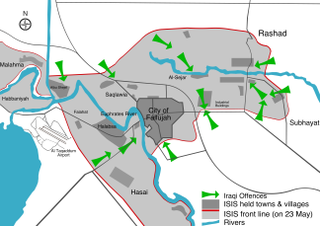
The siege of Fallujah was an offensive that the Iraqi government launched against ISIL in Al-Karmah and in the city of Fallujah, with the aim of enforcing a siege of Fallujah. During the operation, local Sunni residents revolted against ISIL for a period of 3 days, in February 2016. On 22 May, after completing preparations around the city, the Iraqi Army and supporting Shi'ite militias launched the Third Battle of Fallujah.
The Battle of Hit, code named Operation Desert Lynx by Iraqi forces, was an offensive launched by the Iraqi Government during the Anbar offensive, with the goal of recapturing the town of Hīt and the Hīt District from ISIL. After the Iraqi forces recaptured the city of Ramadi, Hīt and Fallujah were the only cities still under the control of ISIL in the Al Anbar Governorate. Iraqi Forces fully recaptured of Hīt and the rest of the Hīt District on 14 April 2016.
The Fall of Baiji was a battle that took place in and around Baiji, Iraq in June 2014. It was fought between Islamic State of Iraq and the Levant (ISIL) forces and those of the Iraqi government. Its first stage included clashes in the city from 11 to 18 June. The second stage was fighting over the control of Baiji oil refinery from 18 to 21 June. ISIL captured both the town and the refinery. On 19 June 2014, the Iraqi Army retook the a refinery in a counter-attack. Fighting continued in Baiji until October 2014, when government forces finally established control, which they have maintained since.
